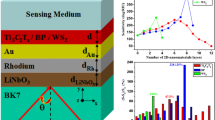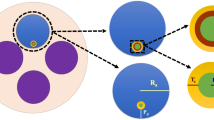Abstract
A novel design of an optical refractive index sensor based on surface plasmon resonance (SPR) has been offered in the article. The structure of the sensor is grounded on a Kretschmann configuration which comprises of CaF2 prism, silver (Ag) metal, beryllium oxide (BeO) nanomaterial, Nickel (Ni), and a heterostructure 2D nanomaterial (blue phosphorene/tungsten diselenide; BP/WS2). The analyte has been sensed on the 2D heterostructure material surface to examine the change in refractive index (RI). For prudent examination of the reflectivity of the proposed sensor, the transfer matrix method (TMM) has been employed. The optimization of sensitivity in terms of thickness and number of layers has also been investigated. Electric field intensity enhancement factor and phase interrogation parameters and normalized electric field distribution have also been utilized to validate the resonance angle position and to justify ultrahigh sensitivity. Utilizing the 2D nanomaterials intensifies the sensitivity of the proposed structure up to 401.2° per refractive index unit (deg/RIU). The FoM and detection accuracy (DA) is optimized up to 178.31 RIU−1 and 0.444 deg−1 respectively. The sensor offers a simple and selective structure with efficient cost and thickness. Additionally, the advantage of being real-time, stable, and label-free detection of an analyte sample with a very small amount of sample makes the proposed sensor a competing technology to be fabricated as a sensor chip for commercial applications.










Similar content being viewed by others
Data Availability
Data will be made available on request.
References
Tamada K et al (2010) Reviews in plasmonics 2010:2012. https://doi.org/10.1007/978-1-4614-0884-0
Yee SS, Gauglitz G (1999) Surface plasmon resonance sensors: review
Suvarnaphaet P, Pechprasarn S (2017) Graphene-based materials for biosensors: a review,” Sensors (Switzerland) 17(10). https://doi.org/10.3390/s17102161
Hoa XD, Kirk AG, Tabrizian M (2007) Towards integrated and sensitive surface plasmon resonance biosensors: a review of recent progress. Biosens Bioelectron 23(2):151–160. https://doi.org/10.1016/j.bios.2007.07.001
Homola J, Yee SS, Gauglitz G (1999) Surface plasmon resonance sensors: review. Sens Actuators B Chem 54(1):3–15. https://doi.org/10.1016/S0925-4005(98)00321-9
Hossain MB, Mehedi IM, Moznuzzaman M, Abdulrazak LF, Hossain MA (2019) High performance refractive index SPR sensor modeling employing graphene tri sheets. Results Phys 15. https://doi.org/10.1016/j.rinp.2019.102719
Rifat AA, Mahdiraji GA, Sua YM, Ahmed R, Shee YG, Adikan FRM (2016) Highly sensitive multi-core flat fiber surface plasmon resonance refractive index sensor. Opt Express 24(3):2485. https://doi.org/10.1364/oe.24.002485
Karki B, Jha A, Pal A, Srivastava A (2022) Sensitivity enhancement of refractive index - based surface plasmon resonance sensor for glucose detection. Opt Quantum Electron 1–13. https://doi.org/10.1007/s11082-022-04004-z
Chadwick B, Gal M (1993) An optical temperature sensor using surface plasmons. Jpn J Appl Phys 32(6):2716–2717. https://doi.org/10.1143/JJAP.32.2716
Ma Y, Fu S, Zhou M (2022) Flexible and highly-sensitive pressure sensor based on controllably oxidized MXene. 1–12. https://doi.org/10.1002/inf2.12328
Hu C, Gan N, Chen Y, Bi L, Zhang X, Song L (2009) Detection of microcystins in environmental samples using surface plasmon resonance biosensor. Talanta 80(1):407–410. https://doi.org/10.1016/j.talanta.2009.06.044
McDonnell JM (2001) Surface plasmon resonance: towards an understanding of the mechanisms of biological molecular recognition. Curr Opin Chem Biol 5(5):572–577. https://doi.org/10.1016/S1367-5931(00)00251-9
Homola J (2008) Surface plasmon resonance sensors for detection of chemical and biological species. Chem Rev 108(2):462–493. https://doi.org/10.1021/cr068107d
Karki B, Uniyal A, Chauhan B, Pal A (2022) Sensitivity enhancement of a graphene, zinc sulfide-based surface plasmon resonance biosensor with an Ag metal configuration in the visible region. J Comput Electron 21(2):445–452. https://doi.org/10.1007/s10825-022-01854-4
Uniyal A, Chauhan B, Pal A, Singh Y (2022) Surface plasmon biosensor based on Bi 2 Te 3 antimonene heterostructure for the detection of cancer cells. Appl Opt 61(13):3711. https://doi.org/10.1364/ao.454789
Singh S (2022) Sensitivity enhancement of SPR biosensor employing heterostructure blue phosphorus/MoS 2 and silicon layer. 1–12
Singh S, Sharma AK, Lohia P, Pravin DKD, Singh K (2022) Design and modelling of high-performance surface plasmon resonance refractive index sensor using BaTiO 3, MXene and nickel hybrid nanostructure. Plasmonics. no. 0123456789. https://doi.org/10.1007/s11468-022-01692-x
Fu H, Zhang S, Chen H, Weng J (2015) Graphene enhances the sensitivity of fiber-optic surface plasmon resonance biosensor. IEEE Sens J 15(10):5478–5482. https://doi.org/10.1109/JSEN.2015.2442276
Sharma AK, Kaur B, Popescu VA (2020) On the role of different 2D materials/heterostructures in fiber-optic SPR humidity sensor in visible spectral region. Opt Mater (Amst) 102:109824. https://doi.org/10.1016/j.optmat.2020.109824
Karki B, Uniyal A, Sharma T, Pal A (2022) Indium phosphide and black phosphorus employed surface plasmon resonance sensor for formalin detection: numerical analysis indium phosphide and black phosphorus employed surface plasmon resonance sensor for formalin detection: numerical analysis. https://doi.org/10.1117/1.OE.61.1.017101
Karki B (2022) PtSe2 and Black Phosphorus employed for sensitivity improvement of surface plasmon resonance sensor
Karki B, Uniyal A, Pal A, Srivastava V (2022) Advances in surface plasmon resonance-based Biosensor technologies for cancer cell detection. Int J Opt 2022. https://doi.org/10.1155/2022/1476254
Karki B, Pal A, Singh Y, Sharma S (2021) Sensitivity enhancement of surface plasmon resonance sensor using 2D material barium titanate and black phosphorus over the bimetallic layer of Au, Ag, and Cu. Opt Commun 508:127616. https://doi.org/10.1016/j.optcom.2021.127616
Srivastava A, Prajapati YK (2019) Performance analysis of silicon and blue Phosphorene/MoS2 hetero-structure based SPR sensor. Photonic Sensors 9(3):284–292. https://doi.org/10.1007/s13320-019-0533-1
Sharma AK, Pandey AK (2018) Blue phosphorene/MoS2 heterostructure based SPR sensor with enhanced sensitivity. IEEE Photonics Technol Lett 30(7):595–598. https://doi.org/10.1109/LPT.2018.2803747
Sharma AK, Gupta BD (2007) On the performance of different bimetallic combinations in surface plasmon resonance based fiber optic sensors. J Appl Phys. https://doi.org/10.1063/1.2721779
Helmersson U, Lattemann M, Bohlmark J, Ehiasarian AP, Gudmundsson JT (2006) Ionized physical vapor deposition (IPVD): a review of technology and applications. Thin Solid Films 513(1–2):1–24. https://doi.org/10.1016/j.tsf.2006.03.033
Dallorto S et al (2018) Atomic layer deposition for spacer defined double patterning of sub-10 nm titanium dioxide features. Nanotechnology 29(40). https://doi.org/10.1088/1361-6528/aad393
Pierson HO (1999) Handbook of chemical vapor deposition: principles, technology, and applications. Noyes Publications
Tang L, Tan J, Nong H, Liu B, Cheng HM (2021) Chemical vapor deposition growth of two-dimensional compound materials: controllability, material quality, and growth mechanism. Acc Mater Res 2(1):36–47. https://doi.org/10.1021/accountsmr.0c00063
Singh MK, Pal S, Prajapati YK, Saini JP (2020) Sensitivity improvement of surface plasmon resonance sensor on using BlueP/MoS 2 heterostructure and antimonene. IEEE Sens Lett 4(7). https://doi.org/10.1109/LSENS.2020.3005942
Wang G, Wang C, Yang R, Liu W, Sun S (2017) A sensitive and stable surface plasmon resonance sensor based on monolayer protected silver film. Sensors (Switzerland) 17(12). https://doi.org/10.3390/s17122777
Singh S, Sharma AK, Lohia P, Dwivedi DK (2021) Ferric oxide and heterostructure BlueP/MoSe2 nanostructure based SPR sensor using magnetic material nickel for sensitivity enhancements. Superlattices Microstruct 163:107126. https://doi.org/10.1016/j.spmi.2021.107126
Nisha A, Maheswari P, Anbarasan PM, Rajesh KB, Jaroszewicz Z (2019) Sensitivity enhancement of surface plasmon resonance sensor with 2D material covered noble and magnetic material (Ni). Opt Quantum Electron 51(1). https://doi.org/10.1007/s11082-018-1726-3
Gupta BD (2012) Surface plasmon resonance based fiber optic sensors. 105–137. https://doi.org/10.1007/978-1-4614-0884-0_4
Srivastava S, Singh S, Mishra AC, Lohia P, Dwivedi DK (2023) Numerical study of titanium dioxide and MXene nanomaterial-based surface plasmon resonance biosensor for virus SARS-CoV-2 detection. Plasmonics 0123456789. https://doi.org/10.1007/s11468-023-01874-1
Mishra AC, Dandapat K, Tripathi SM, Lohia P, Dwivedi DK (2020) Modelling and analysis of chirped long-period grating inscribed in a planer optical waveguide structure for sensing applications. Journal of Optical Communications. https://doi.org/10.1515/joc-2020-0128
Wu L, Chu HS, Koh WS, Li EP (2010) Highly sensitive graphene biosensors based on surface plasmon resonance. Opt Express 18(14):14395. https://doi.org/10.1364/oe.18.014395
Pal S, Verma A, Saini JP, Prajapati YK (2019) Sensitivity enhancement using silicon black phosphorous –TMDC coated surface plasmon resonance biosensor. IET Optoelectron 13(4):196–201. https://doi.org/10.1049/iet-opt.2018.5023
Acknowledgements
One of the authors (Adarsh Chandra Mishra) is very thankful to the Madan Mohan Malaviya University of Technology Gorakhpur, Uttar Pradesh (India), for the technical support.
Author information
Authors and Affiliations
Contributions
Adarsh Chandra Mishra conceived the concept, developed the structure and methodology, collected, investigated all the data, and prepared the initial draft. A. K. Sharma and Pooja Lohia investigated and interpreted the data and reviewed the manuscript. D. K. Dwivedi reviewed and edited the manuscript and provided guidance as a mentor throughout the planning and execution of the research project.
Corresponding author
Ethics declarations
Ethical Approval
This is a theoretical study and does not require any ethical approval.
Conflict of Interest
The authors declare no competing interests.
Additional information
Publisher's Note
Springer Nature remains neutral with regard to jurisdictional claims in published maps and institutional affiliations.
Rights and permissions
Springer Nature or its licensor (e.g. a society or other partner) holds exclusive rights to this article under a publishing agreement with the author(s) or other rightsholder(s); author self-archiving of the accepted manuscript version of this article is solely governed by the terms of such publishing agreement and applicable law.
About this article
Cite this article
Mishra, A.C., Sharma, A.K., Lohia, P. et al. Modelling and Analysis of High-Performing Reconfigurable SPR Refractive Index Sensor Employing Beryllium Oxide, Nickel, and BlueP/WS2 Nanomaterials. Plasmonics 19, 429–438 (2024). https://doi.org/10.1007/s11468-023-02005-6
Received:
Accepted:
Published:
Issue Date:
DOI: https://doi.org/10.1007/s11468-023-02005-6




